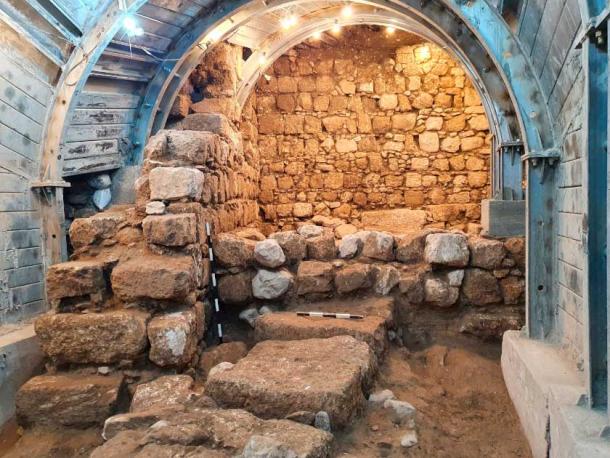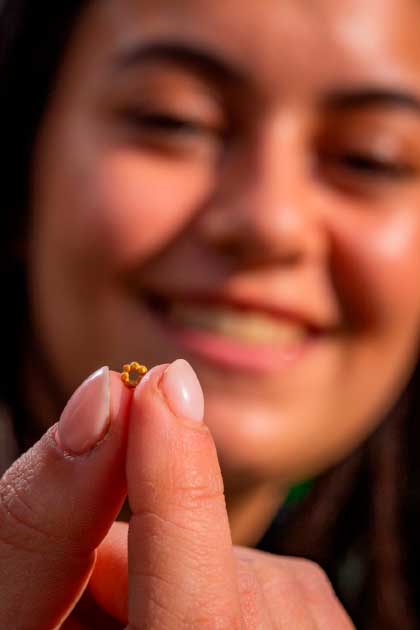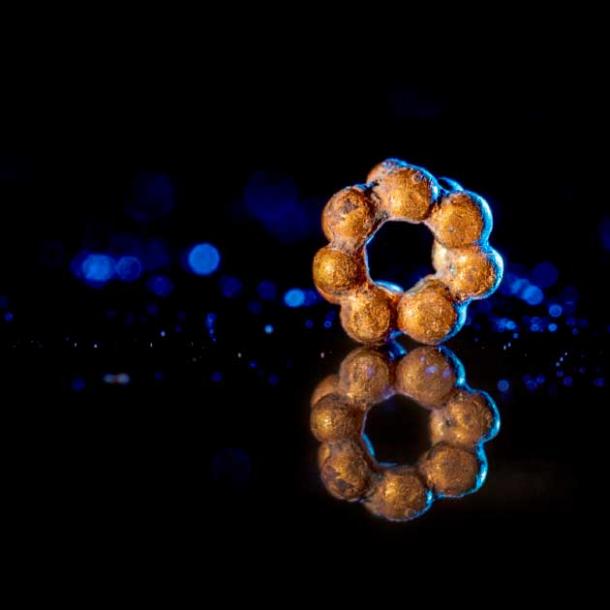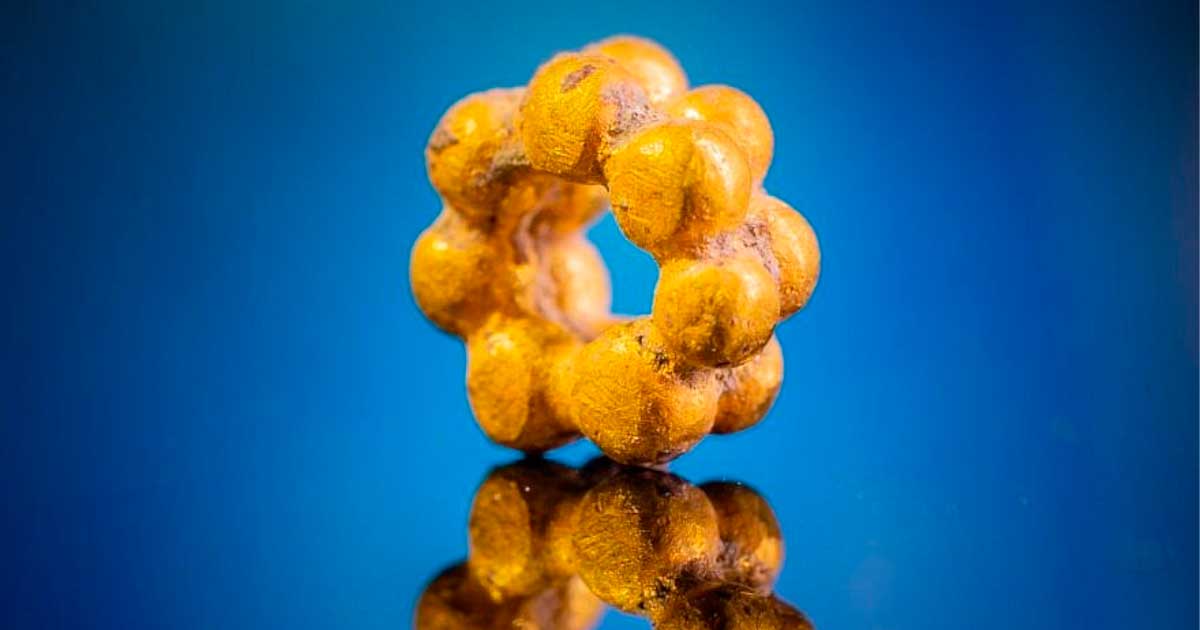Volunteer Finds Intricate 5th-Century Gold Bead in Archaeological Debris
While sifting through dirt and rubble removed from a huge Roman structure discovered during excavations at Pilgrimage Road in the City of David in Jerusalem, a National Service volunteer found a small golden bead of a most peculiar type. The tiny, pure gold object has been dated to at least the fifth century (it could be somewhat older,) and was made from over a dozen miniscule gold balls that were fixed together to create a ring-shaped single bead with a hole in its center. This really is a tiny piece of craft worth examining!
As revealed by the Israel Antiquities Authority (IAA) in a post on their Facebook page, the ultra-rare bead was discovered by a young woman in the National Service named Hallel Feidman, 18, who hails from the town of Bnei Ayish. Along with countless others, she was participating in a large-scale archaeological sifting project that is included as part of the Archaeological Experience at Emek Tzurim National Park in east Jerusalem.
When they sign up for this project, volunteers like Feidman pour dirt and debris removed from various archaeological sites through sieves, in order to sift out any tiny objects that might have been buried in the excavation deposits. The idea is that archaeologists may have overlooked certain items during their initial excavations, and the job of the Archaeological Experience volunteers is to find those hidden treasures.
And in this instance, the sifting project did in fact unearth a supremely valuable object that would make an excellent addition to any treasure chest.
"I poured the pail onto the sieve and began to wash the material that was brought from the excavations in the City of David," Feidman said, describing how she made her amazing discovery. "And then I saw something shiny in the corner of the sieve, different, that I don’t normally see. I immediately approached the archaeologist and he confirmed that I had found a gold bead. Everyone here was very excited.”
In this instance, the dirt being sifted came from the excavation of a large and elaborate Roman-style building that was constructed along Pilgrimage Road approximately 1,600 years ago. The volunteers assigned to sift this through this particular pile of earth knew they were searching for a needle in a haystack, but none dreamed that the ‘needle’ they would find would be made from solid gold.
- City Gate From the Time of King David Unearthed In Miracle Village
- A Question of Faith: Is the Tomb of the Legendary King David Really on Mount Zion?

A section of the grandiose Roman structure where the bead was found. (Ari Levy/Israel Antiquities Authority)
A Discovery for the Ages, Figuratively and Literally
Over the decades no more than a few dozen gold beads have ever been found during archaeological excavations in Israel. This unique, pebbled object certainly stands out, since it would have been extraordinarily difficult and time-consuming to make.
"Throughout all my years in archaeology, I have found gold perhaps once or twice, so to find gold jewelry, is something very, very special," declared Dr. Amir Golani, an Israel Antiquities Authority ancient jewelry expert. “Whoever could afford a piece like this made from gold, was an affluent person, with means.”
Dr. Golani said that the tiny gold object, which can easily be held on the end of a finger, was once part of a longer stringed-bead necklace or bracelet. This raises the possibility that other identical pieces might be found in the dirt and rubble salvaged from the Pilgrim Road archaeological site.
Given how meticulous and thorough the sifting project is, there is a good chance that volunteers will eventually find these other beads, if they are actually there.
- Ancient Mesopotamia and the Rise of Civilization
- Cuneiform Tablets and ‘Envelopes’ Tell of Mesopotamian Sophistication

Bead finder Hallel Feidman holding the rare gold item. (Koby Harati/IAA)
The Tiny Gold Bead Speaks of a Wealthy Owner
According to excavation directors Shlomo Greenberg and Ari Levy, the exquisite golden bead was lost inside a structure that would have been used by elites.
"The bead originated in a grandiose structure which is at least 25 meters long,” the IAA experts explained. “The structure was built on the Pilgrimage Road in the City of David, in a building style that characterizes upscale buildings. The wealth of the building's occupants is evidenced by additional finds that were discovered in it, like imported clay vessels and a decorated mosaic floor.”
The obvious assumption is that the bead belongs to the same time period as the building from which it was extracted. But this may not be the case. While the building has been dated to approximately the fifth century AD, the bead may have been created at an earlier time. It may have been handed down in an elite family for generations. Or it may have been acquired, along with the rest of the necklace or bracelet, from a trader with international connections, meaning the bead could have been made in another part of the world entirely.

The truly meticulous search found the tiny item. (IAA)
Regardless of where or when it was made, there is no questioning the golden ring-bead’s unusual characteristics. It is believed that the technique used to make the fused ring-shaped object was first perfected somewhere in the region of Mesopotamia (modern-day Iraq and parts of Syria, Iran, Turkey and Kuwait), at least 4,500 years ago.
“The most interesting aspect of the bead is its unique and complex production method,” Dr. Golani said. “A good understanding of the materials and their properties is required, as well as control over the heat, in order to, on the one hand, solder the tiny balls together to create a tiny ring, while also preventing overheating which may lead all the gold to melt. Only a professional craftsman could produce such a bead, which is another reason that this find holds great value.”
Beads of a similar style were found in burial caves in Ketef Hinnom near the City of David in Jerusalem, and those objects were dated to the end of the First Temple period. But those beads were made from silver, not gold.
When the Archaeological Experience is Truly Golden
There is no way to link the tiny golden bead to a specific person or designer. But its form and existence tell us a lot about the standards and practices of the culture that produced such a fine object.
"Although it is a tiny find, it is precisely the personal, day-to-day items that manage to touch and connect us more than anything else, directly, to a certain person,” stated IAA Director Eil Escusido. “Even with today's advanced technology, creating something like this would be very complex. A close examination of this object fills one with a deep sense of admiration for the technical skill and ability of those who came before us many centuries ago. "
This find certainly verifies the importance of the Archaeological Experience sifting project, which operates year-round in Emek Tzurim National Park, and has been ongoing for nearly two decades. Over the years volunteers have found rare jewels, coins and pottery pieces from a broad range of historical eras, helping archaeologists fill in the details about the cultures that occupied the lands of modern Israel in the near and ancient past.
Top image: This rare gold bead, dating back at least 1,600 years, was uncovered in dirt taken from a Roman structure in Jerusalem's Emek Tzurim National Park. Source: Ari Levy/Israel Antiquities Authority.
By Nathan Falde




















Comments
That cavern or grotto is obviously NOT Roman construction. No Roman texts talk about quarrying, moving or building with large stones blocks like that. The ONLY explanation is that they are digging in Atlantean-era ruins, and thus finding Atlantean-era artifacts down within. Probably left untouched since the Atlantis event itself, circa 115 BC, adding the zero back to Plato’s timeline. I.e., it's all pre-Ice Age. In light of this near-certainty, was the so-called Bronze Age more just the age of great finds, where the people so came later and settled the ruins came across the bones, mummies and all their impressive possessions (e.g., non-ferrous metals) that had not rusted away over those tens of thousands of years?
Nobody gets paid to tell the truth.